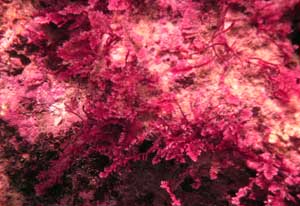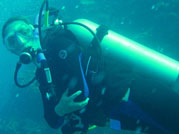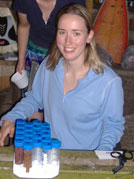Something new under the sea: promising malaria treatment found in Fiji
March/ April 2011 | Volume 10, Issue 2

Photo courtesy of Julia Kubanek
Red algae known as Callophycus serratus contains a
compound found to have strong anti-malarial properties.
The latest promising weapon in the war against malaria comes from seaweed found in Fiji as part of a Fogarty-led program. Animal studies have begun and, if a chemical defense that targets marine fungi in the seaweed proves effective, the ocean may yield the key to defeating a disease that kills more than a million people a year.
The study has been led by Fogarty grantee Dr. Julia Kubanek, a chemical ecologist at the Georgia Institute of Technology in Atlanta, who wanted to discover how marine plants and animals defend themselves against infections. In Fiji, she and her colleagues collected seaweed and other marine species to look for natural antibiotics. They also screen compounds from these organisms for biomedical properties.

Photo courtesy of Julia Kubanek
Chemical ecologist Dr. Julia
Kubanek believes the sea
holds many potential biomedical
treasures.

Photo courtesy of Julia Kubanek
Samples of compounds from
seaweed and other marine
species are screened for
biomedical properties.
Kubanek’s group discovered that red algae known as Callophycus serratus contained compounds called bromophycolides, one of which was found to have strong anti-malarial properties. The compound is able to stop the malaria parasite from neutralizing a toxic byproduct in the infected red blood cell, thus killing the parasite.
“This is not a mechanism of action that is brand new to science,” Kubanek said. The anti-malarial chloroquine works in a similar way, but the malaria parasite has evolved resistance to chloroquine. The seaweed compound, she said, has killed chloroquine-resistant parasites.
“All of these drugs have a limited life span,” Kubanek explained. “The malaria parasite reproduces often and can evolve resistance to drugs. The key to slowing it down is using the drug responsibly and in combination with other drugs.”
Now, in the lab of key collaborator Dr. Karine Le Roch at the University of California-Riverside, the drug derived from the lead bromophycolide compound will be tested on mice infected with malaria - to see whether it’s effective as a cure - and also whether it can prevent infection in healthy mice.
Georgia Tech and UC Riverside now have a U.S. patent on the anti-malarial potential of this class of compound. The lead is very promising, albeit early, and will take a lot of further work to determine if it will be suitable as a drug.
Kubanek’s work is funded by the International Cooperative Biodiversity Groups (ICBG) program - in collaboration with other NIH partners, as well as the National Science Foundation, the U.S. Departments of Agriculture and Energy and the National Oceanic and Atmospheric Administration. The ICBG program encourages biological exploration and biodiversity conservation.
“Without the ICBG program, I wouldn’t be focusing on drug discovery now,” said Kubanek. “The program gave us the opportunity to bring together lots of different scientists to serve the goals of discovery and conservation in Fiji.”
Kubanek said they are learning a lot about medicinal chemistry and pharmacology by seeing how nature has thrived and survived. “What is really valuable about the ICBG program is that we combine the discovery of new therapeutics with the conservation of these natural resources - many of which are only found in developing countries.”
More Information
Stout EP, Prudhomme J, Le Roch K, Hay ME, Franzblau S, Fairchild CR, Aalbersberg W, Kubanek J (2010) Unusual antimalarial meroditerpenes from Fijian red algae. Bioorganic and Medicinal Chemistry Letters 20:5662-5665. DOI: 10.1016/j.bmcl.2010.08.031
To view Adobe PDF files,
download current, free accessible plug-ins from Adobe's website.
Related Fogarty Programs